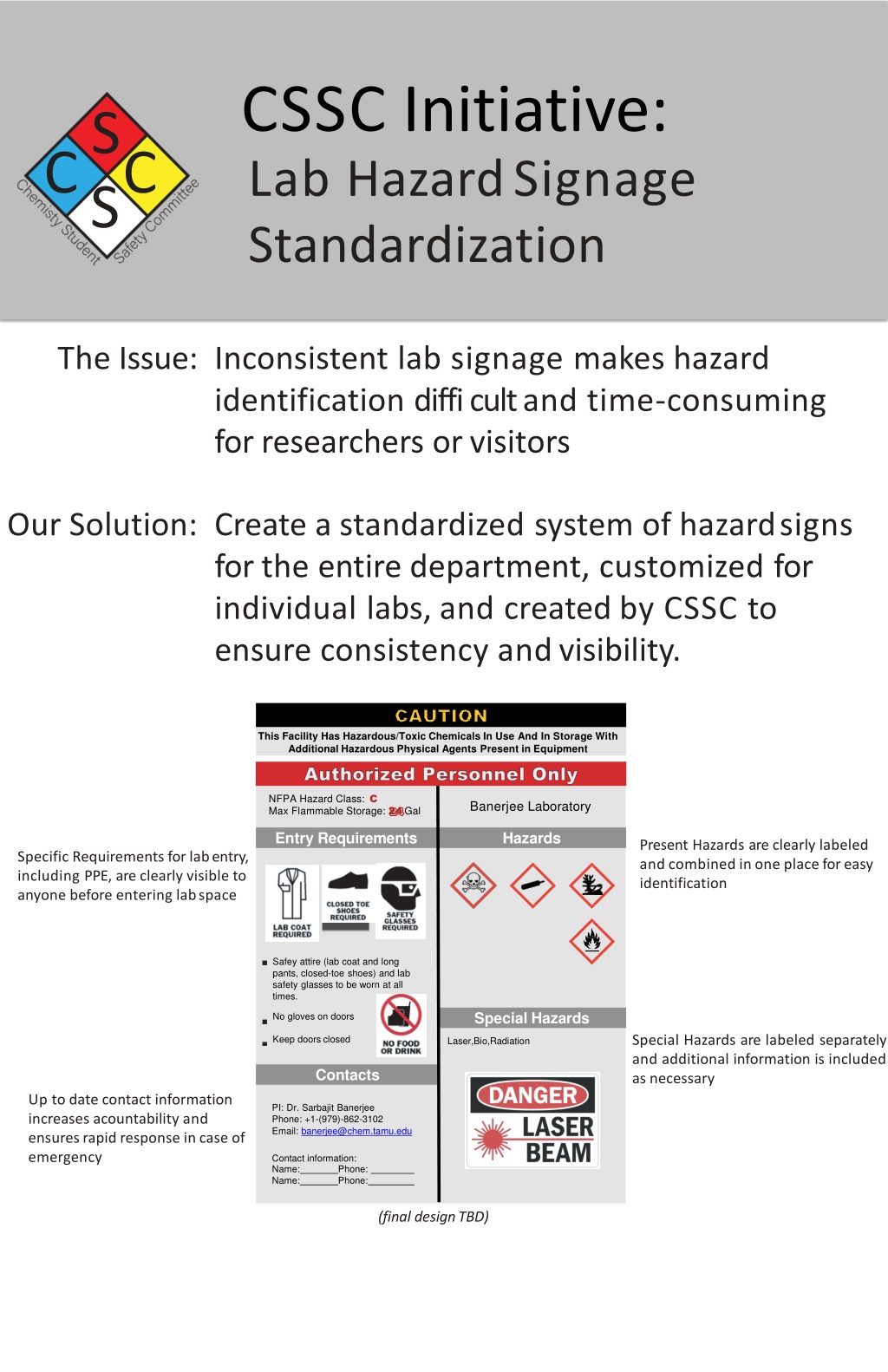
Standardized Hazard Signage for Lab Safety
This initiative aims to improve hazard identification within a department by creating a standardized system of hazard signs customized for individual labs. The system, designed by CSSC, will ensure consistency and visibility, making it easier for researchers and visitors to identify and respond to potential hazards effectively.
Download Presentation

Please find below an Image/Link to download the presentation.
The content on the website is provided AS IS for your information and personal use only. It may not be sold, licensed, or shared on other websites without obtaining consent from the author. If you encounter any issues during the download, it is possible that the publisher has removed the file from their server.
You are allowed to download the files provided on this website for personal or commercial use, subject to the condition that they are used lawfully. All files are the property of their respective owners.
The content on the website is provided AS IS for your information and personal use only. It may not be sold, licensed, or shared on other websites without obtaining consent from the author.
E N D
Presentation Transcript
CSSC Initiative: Lab HazardSignage Standardization S CSC The Issue: Inconsistent lab signage makes hazard identification diffi cult and time-consuming for researchers orvisitors Our Solution: Create a standardized system of hazardsigns for the entire department, customized for individual labs, and created by CSSC to ensure consistency andvisibility. This Facility Has Hazardous/Toxic Chemicals In Use And In Storage With Additional Hazardous Physical Agents Present in Equipment NFPA Hazard Class: C Max Flammable Storage: 24 Gal Banerjee Laboratory Entry Requirements Hazards Present Hazards are clearly labeled and combined in one place foreasy identification Specific Requirements for labentry, including PPE, are clearly visible to anyone before entering labspace Safey attire (lab coat and long pants, closed-toe shoes) and lab safety glasses to be worn at all times. Special Hazards No gloves on doors Special Hazards are labeled separately and additional information is included as necessary Keep doors closed Laser,Bio,Radiation Contacts Up to date contact information increases acountability and ensuresrapid response in case of emergency PI: Dr. Sarbajit Banerjee Phone: +1-(979)-862-3102 Email: banerjee@chem.tamu.edu Contact information: Name: Name: Phone: Phone: (final designTBD)
Instructions/Tips 1. Fill out one template per lab. Red templates are for wet labs, blue for instrument labs, green for teaching labs, and yellow for biological labs. For labs with multiple doors, duplicate the slide to have one slide per door 2. When finished, delete all unneeded slides and email back to CSSC@chem.tamu.edu with your group included in the file name and email. The CSSC will print the first round of door signs and distribute them. Future signs should be printed on 11 x 17 paper. 3. For unique lab circumstances or any other questions, please send us an email and we will help you figure it out. Only change room number Primary Lab Hazards (ex: Hazardous Chemicals, Biohazards, Lasers Present, High Voltage Equipment, Strong Magnetic Fields, Radiation Sources, etc.) Show only PPE needed for entry for this lab Comprehensive Hazard List (copy/paste from hazard slide) Lab contacts
CHEM 001 WET LAB CAUTION! PRIMARY HAZARD PROTECTIVE EQUIPMENT REQUIRED FOR ENTRY Lab Coat Closed Toe Shoes No Food or Drink Gloves Safety Glasses ROOM HAZARDS Principal Investigator: (xxx) xxx-xxxx Grad Student: (xxx) xxx-xxxx Grad Student: (xxx) xxx-xxxx Grad Student: (xxx) xxx-xxxx EMERGENCY CONTACTS Police/Fire/Medical: 911 Campus police: (979) 845-2345 Facilities: (979) 845-4311 EHS: (979) 862-1111 chem.tamu.edu/safety Frame funding graciously provided by Texas A&M EH&S
CHEM 001 INSTRUMENT LAB CAUTION! PRIMARY HAZARD PROTECTIVE EQUIPMENT REQUIRED FOR ENTRY Lab Coat Closed Toe Shoes No Food or Drink Gloves Safety Glasses ROOM HAZARDS Principal Investigator: (xxx) xxx-xxxx Grad Student: (xxx) xxx-xxxx Grad Student: (xxx) xxx-xxxx Grad Student: (xxx) xxx-xxxx EMERGENCY CONTACTS Police/Fire/Medical: 911 Campus police: (979) 845-2345 Facilities: (979) 845-4311 EHS: (979) 862-1111 chem.tamu.edu/safety Frame funding graciously provided by Texas A&M EH&S
CHEM 001 TEACHING LAB CAUTION! PRIMARY HAZARD PROTECTIVE EQUIPMENT REQUIRED FOR ENTRY Lab Coat Closed Toe Shoes No Food or Drink Gloves Safety Glasses ROOM HAZARDS Principal Investigator: (xxx) xxx-xxxx Grad Student: (xxx) xxx-xxxx Grad Student: (xxx) xxx-xxxx Grad Student: (xxx) xxx-xxxx EMERGENCY CONTACTS Police/Fire/Medical: 911 Campus police: (979) 845-2345 Facilities: (979) 845-4311 EHS: (979) 862-1111 chem.tamu.edu/safety Frame funding graciously provided by Texas A&M EH&S
CHEM 001 BIOLOGICAL LAB CAUTION! PRIMARY HAZARD PROTECTIVE EQUIPMENT REQUIRED FOR ENTRY Lab Coat Closed Toe Shoes No Food or Drink Gloves Safety Glasses ROOM HAZARDS Principal Investigator: (xxx) xxx-xxxx Grad Student: (xxx) xxx-xxxx Grad Student: (xxx) xxx-xxxx Grad Student: (xxx) xxx-xxxx EMERGENCY CONTACTS Police/Fire/Medical: 911 Campus police: (979) 845-2345 Facilities: (979) 845-4311 EHS: (979) 862-1111 chem.tamu.edu/safety Frame funding graciously provided by Texas A&M EH&S
PPE Symbols Lab Coat Closed Toe Shoes No Food or Drink Gloves Safety Glasses Sleeved Shirt No Gloves Full Length Pants
Hazard Symbols Biological Hazard Toxic Hazard Flammable Health Hazard Oxidizer Acidic/Corrosive Explosive Laser Source High-Pressure Gas Cylinders Harmful/Irritant Radiation Source High Voltage Source Magnetic Field Environmental Hazard
